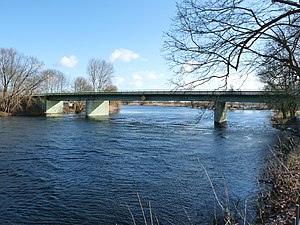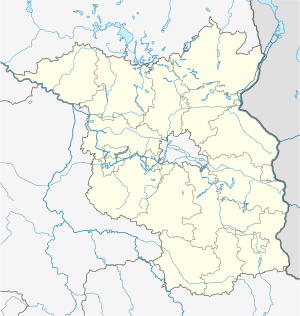Milower road bridge
Coordinates: 52 ° 31 ′ 36 " N , 12 ° 18 ′ 44" E
| Milower road bridge | ||
|---|---|---|
| Milower Bridge 2015 | ||
| use | Road traffic | |
| Convicted | Landesstraße 963 as Milower Straße | |
| Crossing of | Havel | |
| place | Milow | |
| construction | Prestressed concrete bridge | |
| overall length | <85 meters | |
| width | 8.60 meters | |
| Headroom | 4.17 at mean water | |
| completion | 1960 | |
| opening | December 1960 | |
| location | ||
|
|
||
The Milower road bridge , also just called Milower bridge , leads the state road 963 as Milower road over the Havel between the places Milow and Premnitz in the district Havelland in the state of Brandenburg . Until 1949, with a short interruption, the Havel between Milow and Premnitz could only be crossed by ferry. There was a wooden bridge for almost fourteen years, which was replaced by a solid concrete bridge in 1960. The bridge is located at kilometer 92.90 on the Lower Havel waterway .
history
A ferry service across the Havel is mentioned as early as 1742 at the location of today's bridge. She was a lease ferry of the von Treskow and Moritz von Anhalt-Dessau . The local fishermen repeatedly competed with the local ferry between Milow and Premnitz. The carriage ferry was pulled across the river on ropes and chains. The ferry was equipped with a motor in 1926 and from then on pulled itself on steel cables from one bank of the Havel to the other. The residents, including the Milower, have long wanted a bridge over the river. The sovereigns, the landowners and also the ferrymen were against building bridges in their own interest, so that the ferry lasted for centuries. Soldiers of the retreating Wehrmacht sank the ferry shortly before the end of the Second World War in 1945. Shortly afterwards, pioneers of the advancing Red Army built a pontoon bridge with citizens of the area who were obliged to do forced labor. The ferry could be lifted, but in 1948 a wooden bridge began to be built over the Havel. With the opening of the bridge in 1950, ferry traffic ended.
The wooden bridge built at that time was intended to be used for ten years. Due to the heavy traffic and the ice drift of the Havel, it was badly affected by the end of the 1950s. In addition, due to the narrow passage width and height, it increasingly formed an obstacle for shipping on the Havel.
The bridge
In 1959, the construction of a prestressed concrete bridge with only two pillars was started over the 85 meter wide Havel. A passage width of 40 meters for shipping should be guaranteed between the pillars. The usable roadway width is six meters and a footpath 1.30 meters wide was created on each side of the bridge. The construction work was carried out partly with the help of the still existing wooden bridge. 575 cubic meters of concrete were required for the substructure. 582 cubic meters of concrete were used in the superstructure. The total of 32 tendons are each 85.50 meters long and together weigh 25.30 tons. The concreting work took three days and was carried out in a three-shift system. At the end of 1960 the bridge was opened to traffic.
New building
A plan approval procedure for the renewal of the Milow road bridge has been in place since April 2018. This planning approval decision establishes the admissibility of the construction project including all necessary follow-up measures on other facilities with regard to all public concerns it affects.
Temporary bridge
Before the Milower Bridge can be demolished and rebuilt, it is planned to build a temporary bridge above, i.e. to the east. The temporary bridge will be single-lane and traffic will be regulated by a traffic light. Traffic will be able to cross the temporary bridge alternately. There should be no traffic restrictions depending on the size and type of road user. As a makeshift bridge , a system bridge, a universally usable bridge based on the modular principle made of steel, will be erected, which guarantees the required passage width and height for shipping. The temporary bridge will have a clear width of 94.00 meters, with the span of the fields calculated to be 26.54 meters, 40.69 meters and 28.18 meters respectively. Between the railings (BzG) it will be 5.40 meters wide.
Replacement new building
The new Milow road bridge is being built as a girder bridge in composite steel construction over three fields. The abutments are made as box abutments with parallel wings in solid construction. The foundation is planned using large bored piles with a diameter of 1.20. The current pillars of the current bridge can be reused for the new construction. Here there is only a partial new construction in the pier head area. The concrete surface of the pillars is being refurbished. The bridge will have a clear width of 83.00 meters, with the spans being 21.855 meters, 41.38 meters and 21.77 meters respectively. Between the railings (BzG) it will be 12.00 meters wide.
See also
literature
- Hans-J. Uhlemann: Berlin and the Märkische waterways. Transpress Verlag, Berlin 1987, ISBN 3-344-00115-9 .
- Writings of the Association for European Inland Shipping and Waterways e. V. Various years. WESKA (Western European Shipping and Harbor Calendar), Binnenschifffahrts-Verlag, Duisburg-Ruhrort. OCLC 48960431
- Herbert Stertz: Havel shipping under sail . From the fur boat to the chat boat. Media @ Vice, Pritzwalk 2005, ISBN 3-00-016065-5 .
- Herbert Stertz: Havel shipping under steam . Economic factor and experience. Media @ Vice, Pritzwalk 2006, ISBN 3-00-019924-1 .
Web links
- Planning approval decision for the renewal of the bridge (PDF file), accessed on March 11, 2020
- Announcement of the public tender for the construction of the new bridge accessed on March 11, 2020

